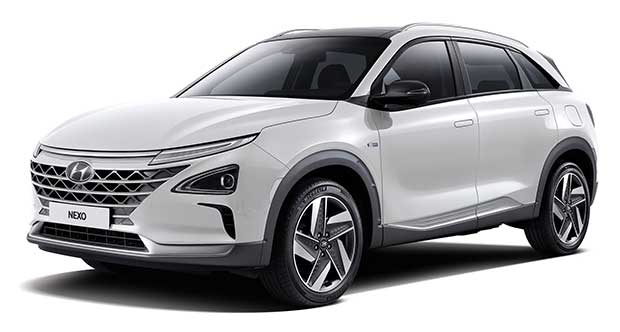2024 Hyundai Nexo Review

The 2024 Hyundai Nexo is a hydrogen fuel cell electric vehicle (FCEV) that offers a unique alternative to traditional battery-electric vehicles (BEVs). FCEVs use hydrogen as fuel to generate electricity, which powers the vehicle’s electric motor. This means that FCEVs can be refueled in just a few minutes, similar to a gasoline-powered car, but they produce zero tailpipe emissions.
The Nexo is a midsize crossover SUV that can seat five passengers comfortably. It has a stylish and modern exterior design, and its interior is well-appointed with high-quality materials and features. The Nexo comes standard with a 10.3-inch digital gauge cluster, a 12.3-inch touchscreen infotainment system, and a suite of advanced driver assistance systems (ADAS).
The Nexo is powered by a 95-kW fuel-cell stack and a 40-kWh battery pack. The fuel-cell stack generates electricity from hydrogen and oxygen, and the battery pack provides additional power during acceleration and peak demand. The Nexo’s electric motor produces 161 horsepower and 291 pound-feet of torque, which is enough to propel the SUV from 0 to 60 mph in 8.4 seconds.
The Nexo has an EPA-estimated range of 380 miles, which is one of the longest ranges of any FCEV on the market. It also has a fast refueling time of just five minutes. However, it is important to note that hydrogen refueling stations are still relatively rare, especially outside of California.
Overall, the 2024 Hyundai Nexo is a well-rounded FCEV that offers a number of advantages over BEVs, such as its longer range and faster refueling time. However, it is also more expensive than BEVs, and the lack of hydrogen refueling stations can make it a less practical choice for some drivers.
Here is a more detailed review of the Nexo’s pros and cons:
Pros:
- Long range (380 miles)
- Fast refueling time (5 minutes)
- Zero tailpipe emissions
- Comfortable and spacious interior
- Well-appointed with high-quality materials and features
Cons:
- Expensive
- Limited availability of hydrogen refueling stations
- Not as fun to drive as some other SUVs
- Who should buy a 2024 Hyundai Nexo?
The 2024 Hyundai Nexo is a good choice for drivers who are looking for a zero-emission vehicle with a long range and fast refueling time. It is also a good choice for drivers who are looking for a comfortable and spacious SUV with a well-appointed interior.
However, it is important to note that the Nexo is more expensive than BEVs, and the lack of hydrogen refueling stations can make it a less practical choice for some drivers. If you are considering buying a Nexo, be sure to weigh the pros and cons carefully to determine if it is the right vehicle for you.
What to expect from the 2024 Hyundai Nexo
The 2024 Hyundai Nexo is expected to be a carryover model, with no major changes from the 2023 model year. This means that buyers can expect the same long range, fast refueling time, and comfortable and spacious interior.
However, there are a few things that buyers should keep in mind when considering a 2024 Nexo:
- Price: The Nexo is more expensive than BEVs, with a starting price of over $60,000.
- Availability: The Nexo is only available for purchase in California.
- Hydrogen refueling stations: Hydrogen refueling stations are still relatively rare, especially outside of California.
- Overall, the 2024 Hyundai Nexo is a well-rounded FCEV that offers a number of advantages over BEVs. However, it is also more expensive and has limited availability.
If you are considering buying a 2024 Nexo, be sure to weigh the pros and cons carefully to determine if it is the right vehicle for you.
Additional thoughts:
- The Nexo is a great choice for drivers who live in California and have easy access to hydrogen refueling stations.
- The Nexo is also a good choice for drivers who need a vehicle with a long range and fast refueling time.
- However, if you are on a budget or live in an area with limited access to hydrogen refueling stations, you may want to consider a BEV instead.